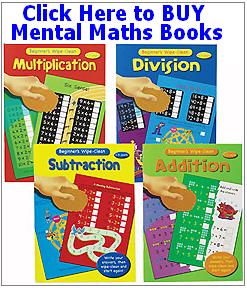Interactive Column Subtraction Demonstrator - Equal Addition Method
Learn Column Subtraction
Equal Addition Method Tutorial
Click here to return to Mental Arithmetic homepage.
|
Column Subtraction is a bit trickier than column addition, but the method we'll look at here is still quite simple to learn. There are two common methods for subtracting numbers arranged in columns - the Decomposition Method which most parents and teachers will have learned in school, and a second method called the Equal Addition Method. In the end both give the same answer, but the equal addition method tends to be the easier to explain and learn thanks to its simplicity. When using the equal addition method, the bottom number is subtracted from the top number in each column, starting in the units column and working left through the tens, hundreds, and so on. If the bottom number is larger than the top number in a column, we just add 10 to the top number and add 1 to the bottom number in the next column to the left as shown in the example below:
Therefore since +10 - 10 = 0 we have not changed the final answer, we've just made it easier to calculate. |
Column subtraction using the Equal Addition Method is much better demonstrated than explained, so please try our automatic demonstrator below. Level 1 - 2 digit minus 2 digit, no borrow. Level 2 - 3 digit minus 3 digit, no borrow. Level 3 - 2 digit minus 2 digit, with borrow. Level 4 - 3 digit minus 3 digit, with borrow. Level 5 - 4 digit minus 4 digit, with borrow. Level 6 - 5 digit minus 5 digit, with borrow. press F5 to repeat a level with new numbers. For printable PDF column subtraction worksheets for each of the levels mentioned above click here: Alternatively, you can enter numbers yourself below to see how they one is subtracted from the other using the equal addition method of column subtraction. |
Equal Addition Method - Column Subtraction
The Question is 667 - 216.
Put these numbers into columns.
| 6 6 7 - 2 1 6 |
Look at the units column.
We have 7 - 6 = 1, so write 1 at the bottom of the units column.
| 6 6 7 - 2 1 6 |
| 1 |
Look at the tens column.
We have 6 - 1 = 5, so write 5 at the bottom of the tens column.
| 6 6 7 - 2 1 6 |
| 5 1 |
Look at the hundreds column.
We have 6 - 2 = 4, so write 4 at the bottom of the hundreds column.
| 6 6 7 - 2 1 6 |
| 4 5 1 |
So using the equal addition method, we have worked out that 667 - 216 = 451
Press F5 for another example.
All worksheets published online at Mental-Arithmetic.co.uk are free to print without modification
for non-commercial use by schools, children, parents, and care givers.
© 2010-2021 Mental-Arithmetic.co.uk - All Rights Reserved
